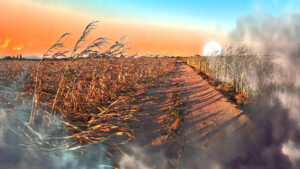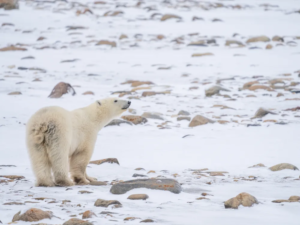Herring off western coast will ‘teeter on edge of complete collapse’ if commercial fishing continues at current level, says report
First Nations and conservationists are warning that Pacific herring populations are “collapsing” off Canada’s western coast, and are appealing for a moratorium on commercial fishing until the critical species can rebuild.
Emmie Page, a marine campaigner with the organization Pacific Wild, said in the past, five large commercial herring fisheries opened each year on the coast.
“Four have since closed because they have very little to no spawn,” she said.
A recent report by Pacific Wild concludes that the Pacific herring fishery is unsustainable and warns that if the government continues to allow fishing at the current level, “herring along Canada’s west coast will teeter on the edge of complete collapse”.
“Currently, we are managing herring to economic and biological decimation,” the report argued.
The small, oily fish are a key food source for various species along the coast including Chinook salmon, which are in turn the main food source for endangered southern resident killer whales. According to Pacific Wild, up to 88% of the commercial catch is reduced to meal and oil to feed farmed Atlantic salmon. Herring roe, equaling about 12% of the catch, is sold, but declining in value, the group’s analysis states.
The Tsawout hereditary chief, Eric Pelkey, said his community enjoyed a healthy herring fishery for generations, and it was a staple food in his community as well as a valued trading item. He added that his nation hasn’t been able to fish for herring for about two decades because the stocks have been decimated.
“There’s no availability to us in our area, our people haven’t been accessing the fishery, there’s been very little herring in our territory,” he said in an interview.
“It is pretty apparent to everybody that it’s collapsing.”
The W̱SÁNEĆ Leadership Council, which represents Pelkey’s nation and two others, has written letters to the fisheries minister asking for a moratorium on commercial Pacific herring fishing since February 2020, but has never received a response, Pelkey said.
The fisheries department said it is committed to responsibly managing the commercial Pacific herring fisheries to ensure the sustainability of the stock. It says that herring populations have long been stable in the remaining major fishery, which opened this year at a 20% harvest rate.
“Herring populations naturally fluctuate from year to year,” it said. “The department’s management approach is designed to respond to a varying abundance of herring by adjusting fishing opportunities accordingly to protect the stock.”
Another First Nation, the Gwa’sala-’Nakwaxda’xw Nations, recently filed an injunction application in federal court seeking to stop the fisheries department from granting a smaller commercial herring fishing license in its territories. It was denied.
The nation said in a statement that for the third year in a row, community members will need to purchase herring roe from other nations instead of harvesting it themselves, out of concern for dwindling herring numbers.
“We continue to be surprised by the way the Department of Fisheries and Oceans ignores our input and concerns,” said Patty Walkus, elected chief.
“We have been fishing these waters for thousands of years … We are extremely disappointed that, once again, our traditional laws and knowledge have not been taken into account.”
Pacific herring is a coastal schooling species that can be found from Alaska to Mexico. In the US, scientists have also marked declines in certain Pacific herring populations, but did not consider them significant enough to warrant listing herring under the Endangered Species Act, according to the US National Oceanic and Atmospheric Administration.




